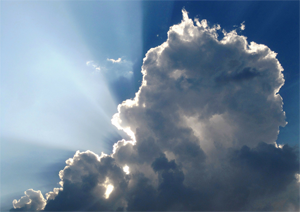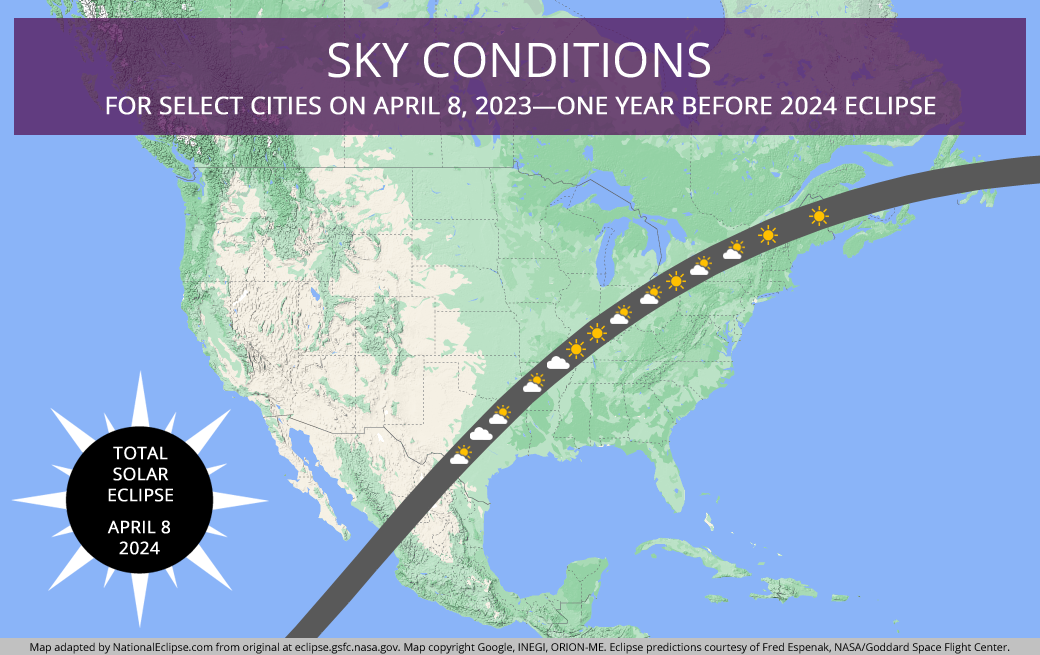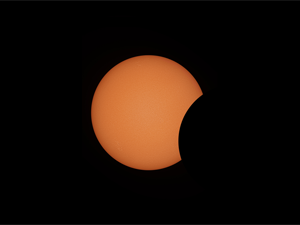(This is an archived page about the total solar eclipse that occurred on April 8, 2024. For information on future eclipses, please see our Upcoming Eclipse Maps page. For a recap of how the weather actually turned out on April 8, 2024, read this short blog post.)
 What will the weather be like on April 8, 2024? That's the question everyone will be asking in the days leading up to the 2024 total solar eclipse. Indeed, one of the most important factors to consider, both when planning an eclipse trip and in the days leading up to an eclipse, is the weather. A few stray clouds at the wrong moment can ruin months and even years of planning!
What will the weather be like on April 8, 2024? That's the question everyone will be asking in the days leading up to the 2024 total solar eclipse. Indeed, one of the most important factors to consider, both when planning an eclipse trip and in the days leading up to an eclipse, is the weather. A few stray clouds at the wrong moment can ruin months and even years of planning!
During the historic 2017 total solar eclipse in America, much of the western U.S. enjoyed clear skies along the path of totality while clouds and even storms spoiled the view along the path in some parts of the central and eastern U.S. Some long-term projections were accurate while others missed the mark. As many people discovered, climate is not the same as weather and clouds can appear at any time, especially in higher elevations, so eclipse chasers need to remain mobile on eclipse day and be ready to move quickly to another location if clouds move in. In 2017, many people found clear skies just a short drive away from their original clouded-out locations!
Although NationalEclipse.com is not an eclipse weather forecasting site, below we provide some general information about what weather experts believe the weather might be like on eclipse day along the 2024 path of totality in the U.S. We also include a chart showing what the weather was like in some of the large and noteworthy U.S. cities along the eclipse path on April 8, 2023—exactly one year before the 2024 total solar eclipse. The information on this page should be used to generally evaluate weather prospects for April 8, 2024. Once you select a destination and arrive there, the most important thing you can do is monitor short-term weather forecasts for your viewing site in the days leading up to the eclipse and be prepared to move to another nearby location if necessary.
The general consensus among weather experts is that the weather odds for a successful eclipse viewing on April 8 along the path of totality in the United States increase in favorability the farther south you are, with the best prospects in Texas. Conversely, the farther north you go, the greater the chance for clouds or bad weather. What follows is a state-by-state weather outlook, gleaned from a variety of sources, for each of the 13 U.S. states along which the path of totality will travel on April 8, 2024.
TEXAS—Texas is widely considered to have the best eclipse-day weather prospects in the United States. More specifically, eclipse weather forecasting site eclipsophile.com points out that, in Texas, "the north [or west] side of the track has a notably sunnier April climate than the south [or east]." In general, the farther south you are for the 2024 eclipse, the better your weather odds—and you can't get any farther south along the path of totality in the U.S. than Texas. Notwithstanding this happy weather outlook, it should be noted that thunderstorms are already a possibility in Texas in early April, although they tend to develop later in the afternoon when the eclipse shadow will have already passed.
OKLAHOMA—The weather outlook along the path of totality in Oklahoma is comparable to the relatively favorable prospects in northern Texas. The chances of cloudy skies increase only slightly along the eclipse path, although eclipse chasers should be wary of some higher elevation areas that could produce clouds in Oklahoma. There is also a chance that thunderstorms could develop along the path during this time of the year.
ARKANSAS—Again, as compared to the promising outlook in Texas, the overall potential for clouds rises only modestly along the eclipse path in Arkansas. However, as is the case with all mountainous regions, the high elevations of the Ouachita and Ozark mountains could result in the formation of clouds that might pose a problem on eclipse day. Also, the south or east side of the path in the upper portion of the state has a notably greater chance for clouds in April as compared to the rest of the path in Arkansas. As is the case in Texas, early-season thunderstorms are possible in Arkansas in April.
MISSOURI—The overall prospects for clear skies in Missouri is similar to the relatively favorable prospects in Arkansas. However, as is also the case in Arkansas, the south or east side of the eclipse track (i.e., the "bootheel" area of Missouri) has a greater chance of cloudy skies as compared to the north or west side of the path. Again, thunderstorms are possible.
ILLINOIS—By the time the eclipse path reaches Illinois, the biggest eclipse-day weather risk comes from springtime storms that are common in the mid-latitude states in April. These storms bring rain, sometimes snow, and always clouds. Besides, or maybe because of, the risk of storms, Illinois also has a greater overall chance of clouds in April than the eclipse path states that preceded it.
KENTUCKY—In terms of weather, the expected outlook within the narrow slice of Kentucky captured inside the eclipse path is about the same as what can be anticipated in Illinois—which is an increase in the overall chance of clouds on eclipse day and the possibility that spring storms could present a major problem.
INDIANA—Indiana takes over where Illinois left off as the overall cloudiness odds along the eclipse path continue to trend up, although gradually. Springtime storms with multiple days of cloud cover are a threat. April showers may bring May flowers, but they don't produce happy eclipse chasers.
OHIO—In Ohio, the gradually increasing trend of the possibility of cloudy skies along the eclipse path continues. But then something surprising happens. About halfway through the state, the centerline and the northern or western side of the eclipse path head out into Lake Erie. Conventional wisdom might hold that cold water equals cloudy skies. Not necessarily! Meteorologists think the frigid waters of Lake Erie in early April might actually inhibit the formation of clouds over and around the lake. Although an eclipse viewing on the water might be a chilly experience, it might also offer better weather prospects than locations farther inland. Of course, major springtime storms are still a possibility, resulting in a complete overcast that can't be mitigated by cold lake waters.
PENNSYLVANIA—The eclipse-day weather prospects along the path of totality in Pennsylvania are similar to those in Ohio: a greater chance of cloudy skies as compared to some of the preceding states, but the potentially cloud-busting effects of Lake Erie that are seen in Ohio also holds true in Pennsylvania. Also like in Ohio, seasonal storms are possible. As always, consult short-term weather forecasts in the days leading up to the eclipse for the best chance of success.
NEW YORK—Now squarely in the Northeast, the increasing possibility of cloudy skies along the path of totality seems to level off here in New York—but only for awhile. And, as is the case with Lake Erie to the west, weather experts think the cold lake waters of Lake Ontario could aid eclipse viewers by preventing clouds from forming above and around the lake. But when the eclipse path reaches the Adirondack Mountains, the chances of cloudy skies increase dramatically over the high peaks and observers will have to contend with the highest probability of clouds seen thus far along the eclipse path. As is the case everywhere in the Northeast, large storm systems can plague New York during this time of the year. Keep in mind, also, that many of the scenic mountain lakes might still be frozen on April 8 and snow in early April is still a distinct possibility.
VERMONT—The eclipse crosses over the Green Mountains in Vermont and, like in the Adirondacks back in New York, the wise eclipse chaser should be wary of cloudy skies resulting from these high elevations and consult short-term weather forecasts for the region. In addition, this entire region is prone to the kinds of major spring storm systems that can ruin an eclipse expedition.
NEW HAMPSHIRE—The potential for gloomy weather along the eclipse path in New Hampshire essentially mirrors those same worries in Vermont. The only difference is that the White Mountains replace the Green Mountains as a possible culprit in the formation of high elevation clouds.
MAINE—Maine's topography is a continuation of the mountainous terrain of the preceding series of states and the high probability of high elevation clouds persists. In fact, this stretch of eclipse track in Maine is perhaps the most prone to cloudy conditions in the entire U.S., especially on the western side of the state. The springtime low pressure systems common in this part of the country are a constant concern too. Don't be surprised if Maine is still covered in snow on April 8.
TOP| City | Low* | High* | Totality Start | Duration* | Sky* |
|---|---|---|---|---|---|
| San Antonio, TX* | 54° F | 73° F | 1:33:01 PM CDT | 2:03 | Sun & Clouds |
| Austin, TX | 54° F | 63° F | 1:36:11 PM CDT | 1:44 | Overcast |
| Fort Worth, TX | 55° F | 72° F | 1:40:28 PM CDT | 2:33 | Sun & Clouds |
| Dallas, TX | 54° F | 73° F | 1:40:43 PM CDT | 3:51 | Sun & Clouds |
| Hot Springs, AR | 54° F | 70° F | 1:49:29 PM CDT | 3:37 | Sun & Clouds |
| Conway, AR | 54° F | 70° F | 1:51:08 PM CDT | 3:53 | Sun & Clouds |
| Little Rock, AR | 54° F | 70° F | 1:51:41 PM CDT | 2:20 | Sun & Clouds |
| Jonesboro, AR | 54° F | 61° F | 1:55:37 PM CDT | 2:21 | Overcast |
| Cape Girardeau, MO | 45° F | 70° F | 1:58:22 PM CDT | 4:06 | Sun |
| Carbondale, IL | 43° F | 64° F | 1:59:16 PM CDT | 4:08 | Sun |
| Paducah, KY | 48° F | 66° F | 2:00:50 PM CDT | 1:31 | Sun |
| Evansville, IN | 43° F | 64° F | 2:02:37 PM CDT | 3:03 | Sun |
| Henderson, KY | 43° F | 64° F | 2:02:43 PM CDT | 2:30 | Sun |
| Terre Haute, IN | 36° F | 64° F | 3:04:23 PM EDT | 2:57 | Sun |
| Bloomington, IN | 37° F | 63° F | 3:04:52 PM EDT | 4:02 | Sun |
| Indianapolis, IN | 39° F | 61° F | 3:06:04 PM EDT | 3:49 | Sun & Clouds |
| Muncie, IN | 36° F | 61° F | 3:07:35 PM EDT | 3:47 | Sun |
| Dayton, OH | 32° F | 57° F | 3:09:29 PM EDT | 2:43 | Sun & Clouds |
| Toledo, OH | 32° F | 50° F | 3:12:17 PM EDT | 1:53 | Sun |
| Cleveland, OH | 32° F | 54° F | 3:13:46 PM EDT | 3:49 | Sun & Clouds |
| Akron, OH | 30° F | 55° F | 3:14:14 PM EDT | 2:46 | Sun |
| Erie, PA | 27° F | 43° F | 3:16:24 PM EDT | 3:40 | Sun |
| Niagara Falls, NY | 27° F | 46° F | 3:18:19 PM EDT | 3:31 | Sun |
| Buffalo, NY | 27° F | 46° F | 3:18:21 PM EDT | 3:45 | Sun & Clouds |
| Rochester, NY | 27° F | 45° F | 3:20:09 PM EDT | 3:39 | Sun & Clouds |
| Syracuse, NY | 27° F | 48° F | 3:23:04 PM EDT | 1:24 | Sun & Clouds |
| Burlington, VT | 28° F | 45° F | 3:26:08 PM EDT | 3:15 | Sun |
| Montpelier, VT | 25° F | 39° F | 3:27:39 PM EDT | 1:35 | Sun |
| Presque Isle, ME | 18° F | 34° F | 3:32:09 PM EDT | 2:49 | Sun |
Eclipse data courtesy of Fred Espenak, NASA/Goddard Space Flight Center, from eclipse.gsfc.nasa.gov. Note that times and durations can vary widely even within the same city and some cities are located only partially within the path of totality. All times and durations shown on this page are only representative samples and should be used for general comparison purposes only.
* "Low" and "High" are the daily lows and highs; "Duration" refers to the duration of totality and is expressed in minutes and seconds; "Sky" refers to the general sky conditions that were observed on April 8, 2023, at or near the time of day that totality will occur locally during the 2024 eclipse; large parts of San Antonio, TX, are outside the path of totality
TOP
The following map shows the general sky conditions that were observed on April 8, 2023—exactly one year before the 2024 total solar eclipse—for select cities along the 2024 path of totality at or near the time of day that totality will occur locally during the 2024 eclipse. Please note that this map should only be used to see what might be possible on April 8, 2024, and is not a forecast.

If you arrived on this page looking for information on what kinds of effects a solar eclipse has on the weather, rather than information on eclipse-day weather itself, that's what this section is for. A solar eclipse can indeed have some noticeable effects on the current weather—some subtle and others much more obvious.
 You will probably notice a temperature drop during a solar eclipse. Usually, you can expect about a ten degree (F) drop in temperature during the progression of a total solar eclipse, although drops of even 20 degrees or more have been reported. Logically, the more the Sun is obscured, the more the temperature should drop, although relatively large drops have been reported for some partial solar eclipses (the NationalEclipse.com History page includes a digitized newspaper article from 1834 that, if it can be believed, reports an incredible 28 degree drop in temperature for an 88 percent partial eclipse!)
You will probably notice a temperature drop during a solar eclipse. Usually, you can expect about a ten degree (F) drop in temperature during the progression of a total solar eclipse, although drops of even 20 degrees or more have been reported. Logically, the more the Sun is obscured, the more the temperature should drop, although relatively large drops have been reported for some partial solar eclipses (the NationalEclipse.com History page includes a digitized newspaper article from 1834 that, if it can be believed, reports an incredible 28 degree drop in temperature for an 88 percent partial eclipse!)
A drop in temperature during a solar eclipse can cause another eclipse weather effect—one that could possibly aid eclipse viewers. Although it should never be counted on to guarantee clear skies, a temperature drop might help to dissipate a buildup of heat-driven cumulus clouds that might otherwise get in the way of a successful viewing.
The temperature drives many aspects of the weather and the temperature drop that occurs during a solar eclipse can also have an effect on the wind. As the ground cools due to a decrease in solar radiation, the breeze might die down or even change direction. This happens because warm air stops rising from the cooled-off ground. In fact, this is why hot air balloons usually only launch in the morning or the evening when the ground is cooler and the atmosphere in more stable.
Finally, although not a weather effect, per se, some observers have noticed a strange visual phenomenon on the ground during a total solar eclipse called "shadow bands." Occurring shortly before and after totality, shadow bands manifest as rippling patterns of light and shadow reminiscent of what you might see on the bottom of a pool on a sunny day. Although there's still some debate over what actually causes this, the generally accepted hypothesis is that shadow bands are caused by turbulence in the Earth's atmosphere that refracts the light coming from the narrow solar crescent.
TOP